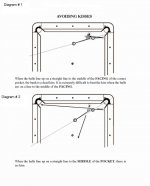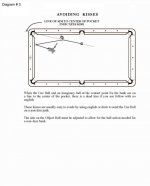Here is the article I wrote for Inside Pool for the July/August 2010 issue. More comprehensive coverage can be found in my books and DVDs.
Beard
Following is the article text:
Romancing the "Stone"
To kiss or not to kiss.
Determining whether a bank shot lays in the "kiss" zone is often misunderstood, and usually winds up as an educated guess. In the following diagrams I have outlined exactly when a bank cannot normally be made using a rolling with or without english. In diagram #1, I deal with the shorter angle cross-corners. If the straight-in angle of the cueball and object ball is lined up and aiming into the pocket facing, the shot is a certain kiss. Left or right english, follow, center, or draw is not going to help you beat that kiss. With a slight angle adjustment, as per diagram #2, lined up to the middle of the back of the pocket, the bank can now be easily made with rolling or center ball, no english.
Diagram #3 is another variation that must be considered. It involves crossing, or passing-over, the object ball from a much more severe angle. Rather than calculate off of a straight-in angle as per dia.#1 & 2, the kiss/no kiss reference point is determined by lining up the actual cut angle needed to make the bank. If an imaginary line from the center of the cueball, extending thru the cut area on the object ball, continues into the middle of the back of the pocket, the kiss is "on." If the line instead, is aiming at the short/bottom rail, you can go ahead and shoot the shot with impunity. Provided of course you are using a natural rolling ball, center ball, left english in this case, or draw. Right hand english when the bank is "on" could result in a kiss.
As an aside to all this, about three years ago I was commentating on an accu-stats Bank pool match that involved Francisco Bustamonte. A bank came up similar to diagram #1 and Busty pondered over it and finally decided to try and make it. The outcome was predictable, he caught a kiss and it cost him the game. The next day Busty was playing a One pocket match and I was again commentating for accu-stats. At a key juncture in the match, the same shot came up, and if he could have made the bank he would have gotten behind the balls and ran out. He apparently remembered the problems he had with the shot the day before, so he hesitated and eventually played a passive safety and lost that game too.
I loooked upon his distress sympathetically, and so I cornered Busty after the match and showed him how the shot could be made. Oh, -- I didn't bother to tell ya'll that it was possible to beat the dia.#1 kiss? I have beaten every kiss I have ever encountered in my whole life, save for my first two wives and those ugly divorces. Sorry, but to explain the solution properly I would have to show it on a table in person. Suffice to say that it requires a masse'. What I did release should hold ya'll for awhile.

